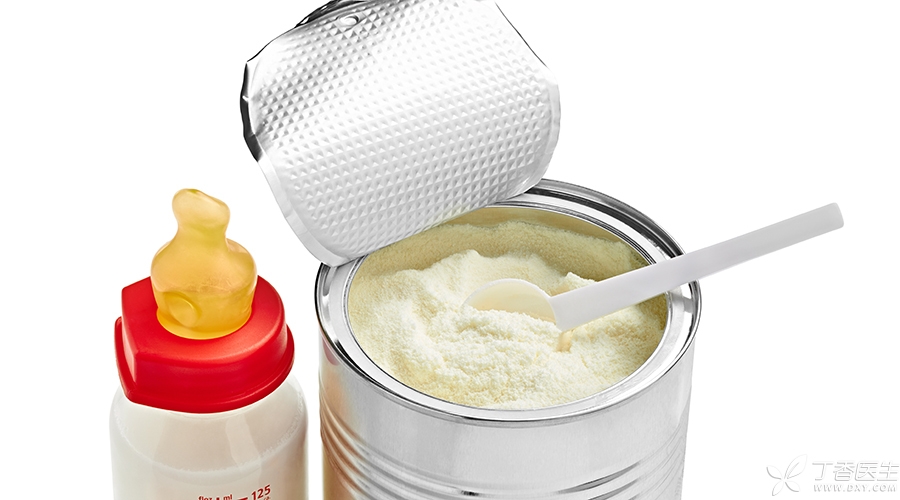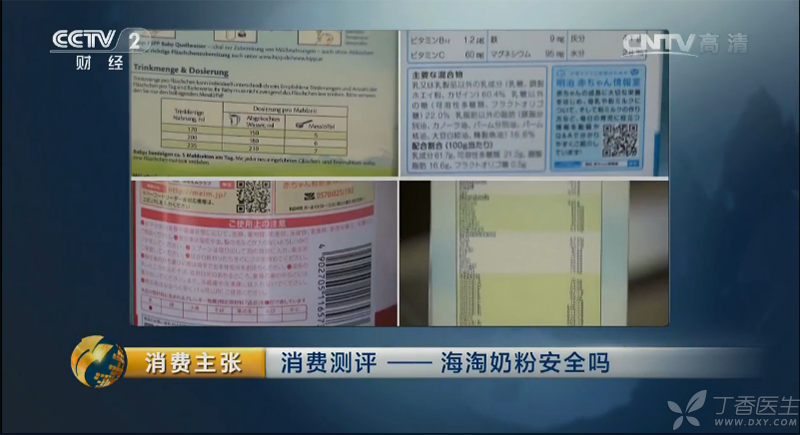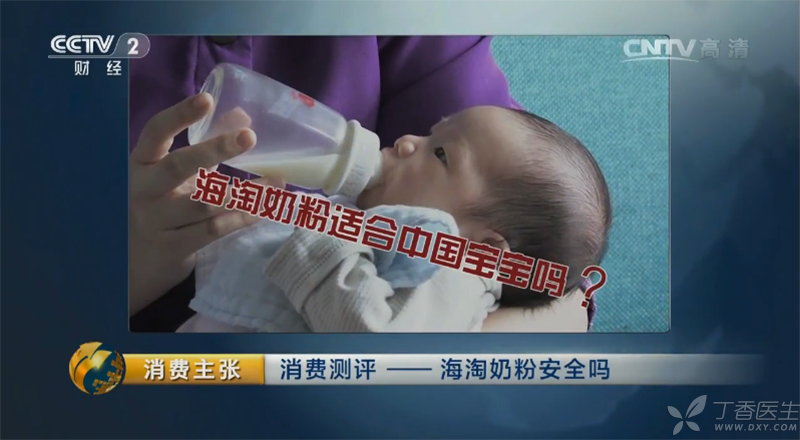
Milk powder is an extremely sensitive and fragile topic in China. Many people are keen on [sea-panning] milk powder, believing that the quality of these [milk powder eaten by foreign children] is guaranteed and the price is cheap.
Recently, a CCTV program asked relevant testing agencies to test the ingredients of 19 hot-selling sea-panning milk powder on the online shopping platform, and found that 8 of them did not meet the Chinese standards.
The program claimed that [it does not meet the food safety standards of our country] [long-term consumption is harmful to the health of the baby] [it can seriously cause mental retardation of the baby]-this reminds readers of [big head doll] and [melamine], which naturally arouses great concern.

Objectively speaking, many interpretations of this test, including the program, are not accurate or objective.
Here, Ding Ma combed the relevant information for her parents, hoping to help readers calmly understand the milk powder standard and rationally choose the milk powder purchasing channels.
The test results are not true.
In fact, what does not meet the Chinese standard in this test result is [nutritional composition requirements], not [safety standards].
Safety standards are aimed at indicators that affect food safety, such as microorganism and pollutant content.
Only the pollutant content was detected in this test, which met the Chinese standard. In other words, the program’s claim that [does not meet China’s food safety standards] is not true.
Infant milk powder is a special kind of food, which has relatively strict requirements on nutritional composition.
Therefore, in the test, the iron, iodine and other indexes of several milk powders are not within the scope stipulated by the Chinese standards. It is reasonable to say that they [do not conform to the Chinese standards].
Of course, the reporter probably can’t distinguish between [safety index] and [nutrition composition requirements], because according to the national [national food safety standard], all unqualified places are called [non-conforming to food safety standards], and no distinction is made between safety index and nutrition composition requirements.
It should be noted that, These sea-panned milk powder were originally produced for the markets of the producing countries, and the quality control objectives of the manufacturers are to meet the local standards. However, because the milk powder standards of the producing countries are different from those of China, for some indicators whose standards are stricter than those of the producing countries, there may be situations [meeting the standards of the producing countries but not meeting the standards of China].
The standard itself differ from country to country
The design concept of formula milk powder is [simulated breast milk]. The word [simulated] is easy to say, but it is not easy to operate in practice. It can only measure a large amount of breast milk, count the content of various nutrients, and then select a [reasonable] numerical range as the standard for milk powder design.
Internationally, the Codex Alimentarius Commission (CODEX) has drawn up a guide to infants’ nutritional needs, but this guide is not a regulation, and this guide does not recommend different standards according to different races.
Therefore, different countries often set their own standards based on this guide and referring to the specific conditions of their own countries, and adjust the numerical range of certain indicators to better meet the needs of their babies. Countries will also use their own standards as law enforcement standards to regulate production.
For example, some indicators may only be adjusted if the makers think that CODEX’s standards are too strict, but in fact there is no need to limit them so badly.
For example, this time the public is very concerned about iron and iodine.
The lower limit of iron content in CODEX standard is 0.1 mg/100 kjoules (0.45 mg/100 kcal), and there is no upper limit, saying that [the upper limit may need to be decided by each country itself].
The Chinese standard adopted this lower limit and set an upper limit of 0.36 mg/100kjoules (1.51 mg/100kcal). The range in the United States is broader than that in CODEX and China, with a lower limit of 0.15 mg and an upper limit of 3.0 mg per 100kcal.
Experts in the program said that [iron exceeds the standard, poisoning caused by excessive iron, gastrointestinal hemorrhage and intestinal hemorrhage], which is theoretically right, but CODEX did not give a numerical value on the issue of [how much exceeds the standard]. The United States thinks that 3 milligrams per 100 kilocalories is no problem, while China thinks that 1.51 milligrams per 100 kilocalories is [excessive].
Controlling the iron intake within the Chinese standard will not affect the nutritional needs of infants, nor will there be any additional risks, but will only require higher quality control for manufacturers.
In other words, it is very good to meet the Chinese standards, but if we do not meet the Chinese standards but only meet the American standards, it will not necessarily lead to [iron excessive poisoning]-after all, the United States is a country of immigrants with all rivers flowing into the sea, and the standards should be formulated not only for a specific group of people, but also for the whole society.
The situation is similar for iodine. The CODEX standard is 2.5 to 14 micrograms per 100kJ (10 to 60 micrograms per 100kC). China has copied this standard, not what many people think [how much iodine is needed in milk powder because of how China is doing].
The U.S. Standard is 5 ~ 75 micrograms per 100kcal, while Japan has not. Here, Japan [has not formulated a standard] only states that manufacturers do not need to monitor this indicator in production, which does not mean that [milk powder does not contain this ingredient].
Similarly, in terms of iodine content, the Chinese standard is stricter than that of the United States and Japan, and meeting the Chinese standard is more [safe] for infants. However, if the Chinese standard is not met but the American standard is met, it is frightening to say that [cretinism and dementia may occur in the most serious cases, affecting the development of the nervous system and the development of the body].

Why not recommend Haitao milk powder?
We said that although Haitao milk powder does not meet the Chinese standards, if it meets the standards of the producing countries or CODEX standards, then it will not be as stated in the program, [long-term consumption is harmful to the health of the baby] [serious mental retardation of the baby].
However, as pointed out by many people in the industry, Haitao milk powder is still not worth recommending!
There are three main reasons:
1. Haitao milk powder is not as good as the purchasing agents say.
Foreign standards are not as strict as those in China, mainly to find a balance between production costs and ensuring the nutritional safety of milk powder. It is logically unreasonable to expect higher quality even though production standards are not so strict.
2. It is difficult to standardize the operation in storage, transportation and distribution.
It is difficult to standardize the operation of Haitao milk powder in the industrial chain of storage, transportation and distribution, and there are many uncertainties, thus there are safety and quality risks that cannot be ignored.
3. Lack of necessary regulation and traceability
Haitao’s entire sales channel lacks necessary supervision and traceability. Compared with formal production and marketing channels, practitioners are much more likely to dare to play tricks.
Choosing a good channel for purchasing milk powder is the key.
In short, China’s milk powder standards do not conflict with CODEX’s international guidelines and standards of other countries. Only in some indicators, Chinese standards limit the scope to a narrower extent.
Such standards are more conservative and can be said to be more [safe]. Therefore, even if milk powder meeting Chinese standards has no additional benefits to baby health, the product quality will be more guaranteed.
After the melamine incident, the image of China’s dairy products, especially milk powder, fell to the bottom. The government and the milk powder industry have made many efforts to rebuild the image and win the trust of consumers. However, once trust is destroyed, it is difficult to rebuild it.
Although in recent years, the testing of domestic milk powder has rarely failed, but consumers still do not buy it. This is not only the sorrow of the industry, but also the helplessness of the government, but there is nothing wrong with the choice of consumers.
If you want to buy imported milk powder, you should still buy products imported through regular channels (that is, the so-called [original imported milk powder] or [national milk powder]).
Although it is produced in other countries like Haitao milk powder, in order to legally import these products into China, they must meet Chinese standards. Moreover, in the import process, both logistics and testing have good supervision and traceability, and the reliability is naturally much higher than that of Haitao products.
